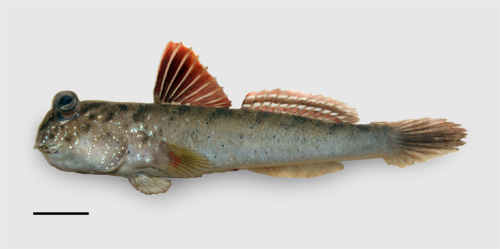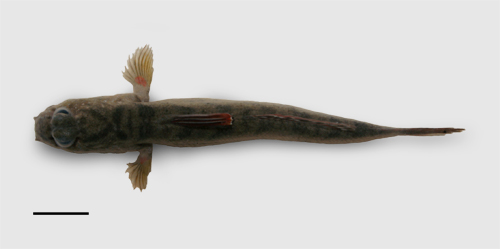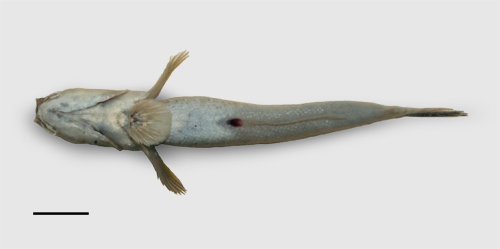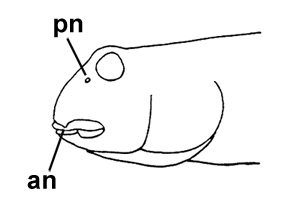Maximum recorded length:
77 mm SL (Khaironizam & Norma-Rashid, 2002)
Live colouration
(Murdy & Takita, 1999;
Khaironizam & Norma-Rashid, 2002):
body ground colour golden brown on dorsum and flanks, dorsally darker; venter witish; numerous, iridescent blue speckles scattered on flanks, cheeks, throat and snout, as large as the exposed field of the underlying scale; and fewer, scattered black speckles on flanks, smaller than the exposed field of the underlying scale;
7-8 irregular saddle like, diagonal, brown bars on dorsum, not reaching the lateral midline; the 2nd bar may become darker, forming a dorsal dark blotch behind the operculum; on the nape 4 brown blotches forming an "X" are sometimes visible.
D1 reddish brown with white spines; margin transparent. D2 with 1-2 proximal series of red spots, a medial brown
stripe sandwiched between two white stripes, and a reddish margin; anal fin hyaline; pectoral fins dusky to yellowish, with crescent reddish
blotches basally on rays; caudal fin dusky to grey in background, medially darker; pelvic fins ventrally white, dorsally dusky
along rays
Colouration on preservation (Murdy & Takita, 1999;
Khaironizam & Norma-Rashid, 2002;
pers. obs.: Peninsular Malaysia, Sumatra):
ground colour grey to pale brown; saddle-like dorsal bars may be visible: 2nd bar more evident
than the other ones; on the nape are sometimes visible 4 dark blotches forming an "X"; venter paler; scattered black speckles on flanks, smaller than the exposed field of the underlying scale. D1 brown, in some
specimens anteriorly darker; margin and spines transparent; D2 background transparent, with a brown medial stripe and 1-2 proximal series of pale spots with a thin
dark brown border (‘ocular’ spots); distal margin and rays pale brown; anal fin hyaline; pectoral fins hyaline to grey to pale brown; in some specimens, a brown blotch is present on the muscular part of the fin; caudal fin pale brown, often
medially darker; pelvic fins whitish-grey on the ventral side, dorsally with few, tiny brown speckles
Diagnosis (Murdy & Takita, 1999):
total elements of D2 14-15;
total elements of anal fin 13-15;
length of anal fin base 21.8-29.0%SL; length of D2 base 22.5-26.7%SL; scattered black tiny speckles on flanks; D1 without stripes nor spots; D2 with a brown medial stripe sandwiched by white stripes and proximal series of red spots in live specimens; a dark medial stripe with proximal series of white ocular spots in preserved ones; dorsal fins not connected by membrane; caudal fin medially darker; anal fin hyaline, with no spots or stripes; pelvic fins with a strong frenum and completely fused by a basal membrane along innermost rays.
The genus is yet undefined by synapomorphies
Diet:
carnivorous, opportunistic (crustaceans, insects, etc.:
Khaironizam & Norma-Rashid, 2002a, b)
Reproduction:
the details of its reproductive
cycle have not been described in literature: it probably follows the general model proposed for all
the congeneric species (see also Reproductive behaviour); no published study is available
|
Ecological notes (pers. obs.: Peninsular Malaysia):
locally abundant inside mangrove forests from the lower to the higher intertidal zone, in this latter case being more abundant on the beds of ephemeral inlets during low tide
middle: Kukup Is., Johor, Malaysia: high mangrove forest at high spring tide; here this species is abundant (photo: G. Polgar, 2007)
|
|
A: an individual on an emerged root at high tide
(photo: G. Polgar; Kukup Is., Peninsular Malaysia, 2007); B: a close-up of the nape: the "X" blotch is discernible (photo: G. Polgar; Kukup Is., Peninsular Malaysia, 2007); C: another close-up: note the high and vertical profile of the snout (photo: G. Polgar; Kukup Is., Peninsular Malaysia,
2007); D: an individual perching on a root at high tide: note the darker saddle-like bar behind the operculum (photo: G. Polgar; Kukup Is., Peninsular Malaysia, 2007); E: P. spilotus in aquarium floating at water surface (photo: G. Polgar; Kukup Is., Peninsular Malaysia,
2007); F: another close-up in aquarium (photo: G. Polgar; Tg. Piai, Peninsular Malaysia,
2006);
G: the second dorsal fin in a live specimen (photo: G. Polgar; Kukup Is., Peninsular Malaysia,
2007)
|








